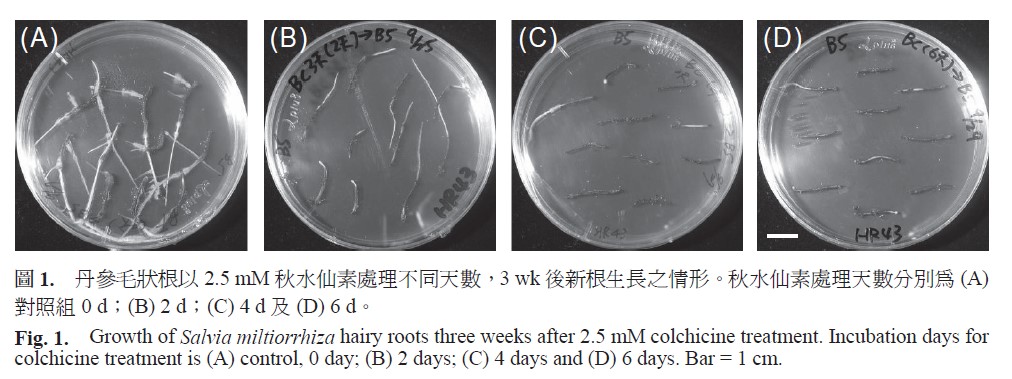All issues

Author:Chi-Ni Hsia*, Uei-Chern Chen, Chin-Yi Tsao, Choi-Yi Lee, and Tzu-Ying Wu
Abstract:
Salvia miltiorrhiza Bunge is a perennial herb of Labiatae Family. Its roots contain rich tanshinones and have been used for long history in traditional Chinese medicine to cure cardiology disease. Using fast growth hairy roots is becoming a new strategy for production of valuable secondary metabolites. Application of polyploidy hairy roots may provide an advanced approach to enhance in vitro secondary metabolite production. The objective of this study was to establish an efficientpolyploidy induction method for S. miltiorrhiza to generate suffiient amounts of polyploidy hairy roots for selection of high medicinal content hairy root lines. Hairy roots induced from in vitro leaves of dipoloid S. miltiorrhiza plants were used as induction explants. Ploidy of regenerated roots derived from colchicine treatments were analyzed using a flow ytometry. A leaf from a 2 N plant was used as the control for flowcytometry which would indicate as 2 C (complement quantity). Root explants were cultured in a solid medium containing with 2.5 mM colchicine for 2, 4 and 6 days to induce polyploidy hairy roots. Treatment of 2-day-exposure colchicines had the highest root formation rate of 80%. The highest polyploidy induction rate of 52.4–55% was obtained from 2- and 4-day-exposure of colchicine. Furthermore, root explants of tips and sections were used as induction explants incubated in a liquid medium containing 1.25 mM and 2.5 mM colchicine for 1, 2 and 3 days to induce polyploidy. It was found that explant type and exposure duration of colchicine had significanteffects on root formation and polyploidy induction rate however effect of colchicine concentration was found not significantl. The highest root formation rate was found from root tip explant for 2-day-exposure. The highest 4 C induction rates were found from either 2- or 3-day-exposure of the tip explant. In conclusion, root tips are more suitable explants than that of root sections for in vitro polyploidy induction. Root tip explant incubated in a solid medium containing 2.5 mM colchicines or in a liquid medium containing 1.25 mM colchicines for 2-day-exposure had the 4C hairy root induction rate higher than 55%. A total 33 lines of 4C hairy roots were subcultured to a new medium for 8 weeks of culture. The average biomass obtained from 4C hairy root lines showed only in 49% of the diploid hairy roots. In contrast, the average contents of cryptotanshinone, tanshinone I, and tanshinone IIA obtained from 4 C hairy root lines were all found higher than that of the diploid hairy roots. Moreover, an 11.2 folds increasing of the cryptotanshinone contents obtained from 4 C hairy root lines and making a 2.6 folds increasing for the total tanshinone production than that of the 2 C hairy roots.
Key words:Salvia miltiorrhiza Bunge, Hairy root, Colchicine, Polyploidy, Tanshinone
Download:![]() PDF Links
PDF Links
- 1. Using Digital Soil Mapping to Predict Soil Organic Carbon Stocks in Zhuoshui River Basin
- 2. Taxonomic Review of the Genus Asiophrida Medvedev, 1999 in Taiwan (Insecta: Coleoptera: Chrysomelidae: Galerucinae: Alticini), with Notes on Biology
- 3. Development of a Technique for Forecasting (or Pre-Detection) Anthracnose Disease Incidences of Green Mature Bagging Mango Fruits
 Submit your manuscript
Submit your manuscript
 Guide for authors
Guide for authors